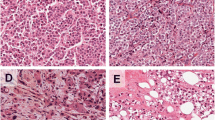Abstract
One hundred and seventy-one cases of operable invasive lobular carcinoma, presenting over an 11-year period, were reviewed. Histological subtypes were investigated to determine differences in their clinical behaviour and whether these differences could be explained by histopathological features. Five subtypes were identified: mixed (45.6%), classical (30.4%), tubulo-lobular (13.5%), solid (6.4%) and alveolar (4.1%). The median follow-up period was 64 months and the median age 54 years. The 12-year actuarial survival rate was 100% for the tubulo-lobular subtype, but only 47% for the solid variant. Similar differences were found in the disease free interval, locoregional and distant metastatic rates between these two subtypes. The tubulo-lobular tumours were more likely to be of good histological grade and node negative. The other three subtypes did not differ significantly in their histopathological parameters, reflected in similar clinical behaviour. They occupied an intermediate position between the other two subtypes in terms of prognosis.
Similar content being viewed by others
Author information
Authors and Affiliations
Rights and permissions
About this article
Cite this article
du Toit, R., Locker, A., Ellis, I. et al. Invasive lobular carcinomas of the breast – the prognosis of histopathological subtypes. Br J Cancer 60, 605–609 (1989). https://doi.org/10.1038/bjc.1989.323
Issue Date:
DOI: https://doi.org/10.1038/bjc.1989.323
- Springer Nature Limited
This article is cited by
-
Tumor-infiltrating lymphocytes are associated with poor prognosis in invasive lobular breast carcinoma
Modern Pathology (2020)
-
New Therapeutic Approaches for Invasive Lobular Carcinoma
Current Breast Cancer Reports (2014)
-
Invasive lobular carcinoma arising in accessory breast tissue
World Journal of Surgical Oncology (2013)
-
Invasive lobular carcinoma: response to neoadjuvant letrozole therapy
Breast Cancer Research and Treatment (2011)




